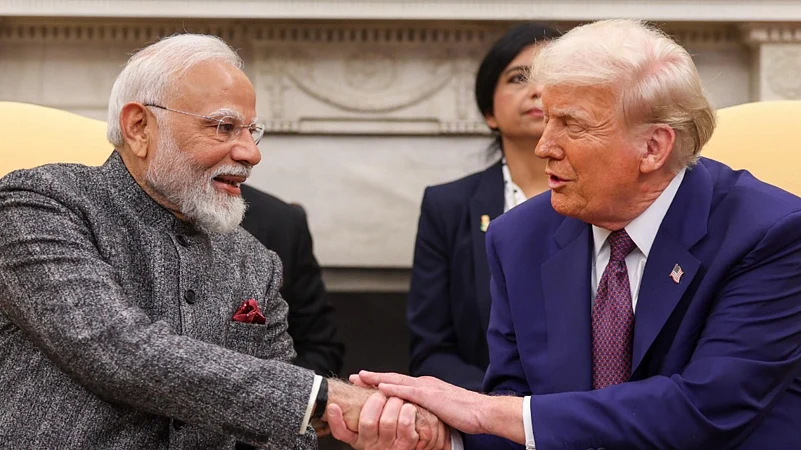Prime Minister Narendra Modi met US President Donald Trump on February 13, 2025 in Washington as a part of his two-day visit to the US. Following the visit, Indian stock markets opened flat a day later, on February 14, with the 30-share Sensex opening at 76,388.99 and the Nifty 50 opening at 23,096.45.
The Sensex also declined 0.91 per cent to hit an intra-day low of 75,439.64 while the Nifty fell 1.11 per cent to 22,774.85 levels. The benchmark indices made a slight recovery from the day’s lows as the Sensex closed at 75,939.21 levels and the Nifty closed at 22,929.25 levels.
While Modi and Trump aimed to forge stronger ties between India and the US, concerns over Trump’s reciprocal tariff plans for India seem to have spooked the markets.
Before meeting Modi, Trump signed a measure directing the US Trade Representative and Commerce Secretary to propose new levies on a country-by-country basis in an effort to rebalance trade relations.
“I’ve decided, for purposes of fairness, that I will charge a reciprocal tariff, meaning whatever countries charge the United States of America. In almost all cases, they’re charging us vastly more than we charge them but those days are over” Trump said.
According to the Office of The United States Trades Representative website, in 2024, the US goods trade deficit with India stood at $45.7 billion, increasing by 5.4 per cent from 2023. The total US goods trade with India was estimated at $129.2 billion in 2024. US goods exports to India for 2024 stood at $41.8 billion. On, the other hand, US goods imports from India aggregated to $87.4 billion in 2024. Trade tariffs are likely to hamper the trade-ties between the two nations and also affect Indian stock markets.
How Will Indian Markets Be Impacted?
Ravi Singh, senior vice president – retail research at Religare Broking told Outlook Money that Trump’s tariff decisions and foreign investment can impact the Indian stock market heavily, particularly sectors such as IT, textiles and pharmaceuticals, which are exposed to global policies and impact the overall movement of the benchmark indices.
He, however, added that “the overall effect will rely on whether his choices are thought to be favourable or unfavourable to the Indian economy.”
Which Sectors Are Likely To Be Impacted The Most?
On February 14, 2025, all sectoral indices closed in the red following the Modi-Trump bilateral meet and Trump’s announcement related to tariffs. Notably major sectoral indices, such as the Nifty Pharma, Nifty Auto and Nifty Metal closed lower by up to 2.87 per cent. Before the bilateral talks were held, Trump also said that he would impose import taxes on cars, semiconductors and pharmaceuticals “over and above” the reciprocal tariffs later.
Singh said that the tariff decision was likely to impact sectors such as automobiles as high tariffs can negatively impact production costs.
“The reciprocal tariff decision by US President Donald Trump can impact a few sectors heavily including automobiles, electronics and textiles. Auto sector depends more on imports and high tariffs can increase production cost,” Singh said.
Singh noted that if Trump goes through with the policy decision to add import taxes over and above the tariffs for select sectors, sectoral indices such as the Nifty IT could struggle as the prices of semiconductors increase. Additionally indices, such as Nifty Pharma could continue to feel the pain as the cost of production may increase for the industry, resulting in lower profit margins and low exports.
“The US President’s decision on import taxes on cars, semiconductors and pharmaceuticals can heavily impact their respective sectoral indices in India. Nifty IT may face struggle as semiconductors could face high prices which can disrupt global supply chain and impact tech companies where such components are crucial. That can also downgrade growth projects which result in negative stock performance. Nifty Pharma can feel the pain as the rise in tariffs can make production costs expensive which reduces profit margins and low exports,” Singh said.
Which Sectors Are Likely To Gain Post Bilateral Talks
Modi and Trump announced a target of achieving $500 billion in annual trade by 2030. Among the key deals signed between the two countries, Trump and Modi also agreed on a deal to make the US the biggest supplier of oil and natural gas to India.
“The Prime Minister and I also reached an important agreement on energy that will ensure the US to be the leading supplier of oil and natural gas to India, hopefully, the number 1 supplier,” Trump said.
Singh said that the deal is likely to make the US, India’s largest crude oil supplier. He added that this, in turn, could benefit oil refiners in India as they may get easier and cheaper access to refined oil, which could reduce their cost of acquisition and increase their margin.
He also said that the energy sector in India is also likely to benefit from the deal as cheaper energy supplies will be available which may push more companies to invest in wind and solar projects.
“With this deal in future, the US might become India’s largest crude oil exporter. Indian refiners could benefit as they have increased access to cheaper refined oil and can reduce their cost ultimately increasing their margin. For the energy sector, it could be positive as there will be more stable and cheaper energy supplies available so companies can invest more towards wind, and solar projects,” Singh said.
Modi and Trump also agreed to advance defence ties between India and the US and announced plans to sign a new ten-year framework for the US-India Major Defence Partnership. Singh predicted that domestic defence sector companies could face competition from US-based companies following the agreement. However domestic defence companies could gain from collaborations with US based defence sector suppliers which could potentially boost their revenues.
“With increase in imports in defence sector companies could face pressure especially if the products are superior in terms of technology or cost effective. At the same time this could present opportunities for domestic defence companies to collaborate with foreign suppliers, which could potentially boost their revenues, as such collaborations often come with technology transfers, R&D partnerships, and manufacturing contracts,” Singh said.
















